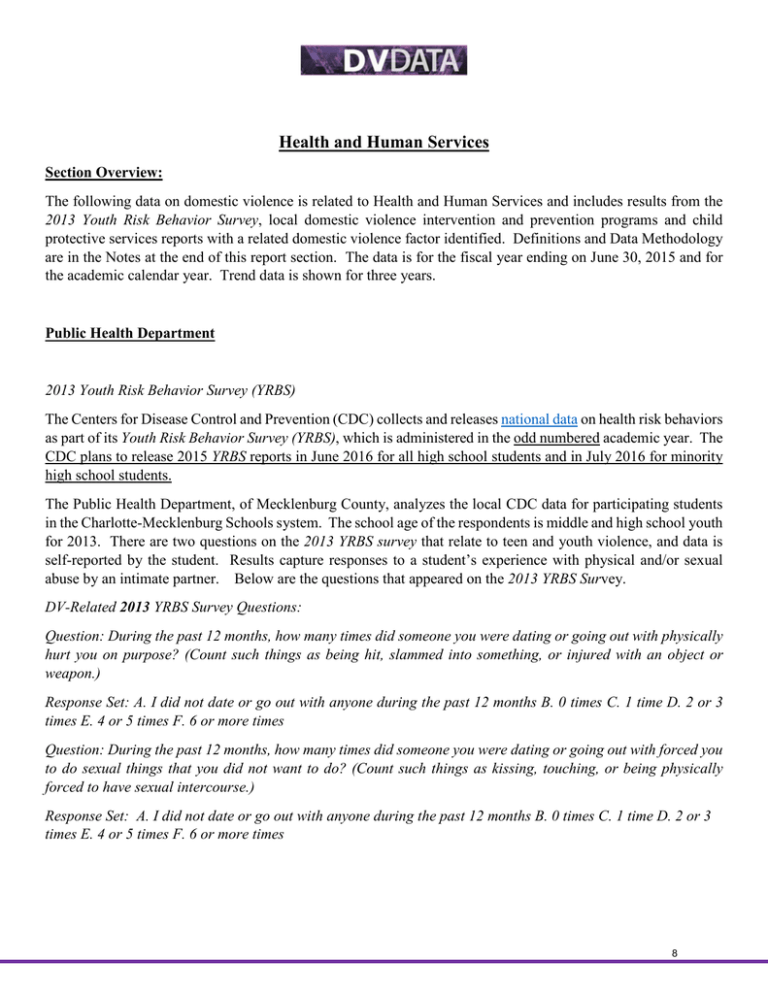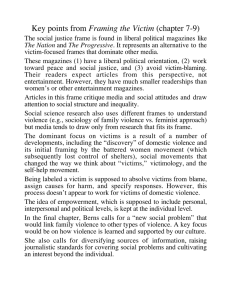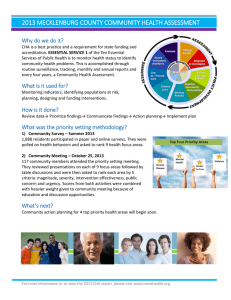
Health and Human Services
Section Overview:
The following data on domestic violence is related to Health and Human Services and includes results from the
2013 Youth Risk Behavior Survey, local domestic violence intervention and prevention programs and child
protective services reports with a related domestic violence factor identified. Definitions and Data Methodology
are in the Notes at the end of this report section. The data is for the fiscal year ending on June 30, 2015 and for
the academic calendar year. Trend data is shown for three years.
Public Health Department
2013 Youth Risk Behavior Survey (YRBS)
The Centers for Disease Control and Prevention (CDC) collects and releases national data on health risk behaviors
as part of its Youth Risk Behavior Survey (YRBS), which is administered in the odd numbered academic year. The
CDC plans to release 2015 YRBS reports in June 2016 for all high school students and in July 2016 for minority
high school students.
The Public Health Department, of Mecklenburg County, analyzes the local CDC data for participating students
in the Charlotte-Mecklenburg Schools system. The school age of the respondents is middle and high school youth
for 2013. There are two questions on the 2013 YRBS survey that relate to teen and youth violence, and data is
self-reported by the student. Results capture responses to a student’s experience with physical and/or sexual
abuse by an intimate partner. Below are the questions that appeared on the 2013 YRBS Survey.
DV-Related 2013 YRBS Survey Questions:
Question: During the past 12 months, how many times did someone you were dating or going out with physically
hurt you on purpose? (Count such things as being hit, slammed into something, or injured with an object or
weapon.)
Response Set: A. I did not date or go out with anyone during the past 12 months B. 0 times C. 1 time D. 2 or 3
times E. 4 or 5 times F. 6 or more times
Question: During the past 12 months, how many times did someone you were dating or going out with forced you
to do sexual things that you did not want to do? (Count such things as kissing, touching, or being physically
forced to have sexual intercourse.)
Response Set: A. I did not date or go out with anyone during the past 12 months B. 0 times C. 1 time D. 2 or 3
times E. 4 or 5 times F. 6 or more times
8
Table 1 shows YRBS data for student respondents from Charlotte-Mecklenburg Schools. In 2013, the number of
middle and high school students participating in the YRBS Survey is 1,417. The overall population of students
participating in the survey is decreasing. Data for 2015 is to be determined.
Of 1,417 students participating, 8.8 percent responded affirmatively (i.e., responses C through F) to their
boyfriend or girlfriend “…physically hurting you on purpose.” In addition, 8.4 percent responded affirmatively
(i.e., responses C through F) to “…forced sexual things when you did not want to.” The question wording and
response set changed for the 2013 academic year, which makes comparisons to 2011 and prior years challenging.
(The questions and response set changes from 2011 to 2013 are provided in the Notes section.)
Table 1: YRBS Survey Data Trend by Academic Year1
# of Students
Participating
Que #1 "Yes"
Responses
Que #2 "Yes"
Responses
2
2005
2007
2009
2011
2013
2015
1,755
1,484
1,713
1,555
1,417
TBD
9.9%
10.7%
11.7%
13.6%
8.8%
TBD
8.7%
7.2%
7.2%
10.3%
8.4%
TBD
Graph 1: YRBS Question #1 Response – “Physically Hurt on Purpose”3
16.0%
% "Yes" Responses
14.0%
13.6%
12.0%
10.0%
8.0%
9.9%
10.7%
11.7%
8.8%
6.0%
4.0%
2.0%
0.0%
2005
2007
2009
2011
2013
9
Graph 1 illustrates the trend line for the YRBS Question “…Physically Hurt on Purpose…” There is a slight
increase in the trend line, which shows the percent of students participating that responded affirmatively to this
question. There is a sharp decrease from 2011 to 2013 in affirmative answers to this question. It is important to
note that the question and the response set changed for this question in 2013. Therefore, it is difficult to make
comparisons from prior years and to draw conclusions from the data.
Graph 2 shows the trend line for the same time period for the YRBS Question “…Forced Sexual Things.” There
is a sharp increase in the affirmative responses to this question from 2009 to 2011. After which, the trend is
slightly decreasing. Prior year comparisons and conclusions from the data are difficult to make as this question
and its response set changed for 2013.
Graph 2: YRBS Question Response “Forced Sexual Things”4
12.0%
% "Yes" Responses
10.0%
8.0%
10.3%
8.7%
6.0%
8.4%
7.2%
7.2%
2007
2009
4.0%
2.0%
0.0%
2005
2011
2013
Community Support Services Department (CSS)
Community Support Services, a department of Mecklenburg County, provides various trauma-informed
intervention and prevention programs to serve the entire family affected by domestic violence. The programs
include the Adult Domestic Violence Victim Services program and Programa Confianza.
10
The Child Witness Services program provides assistance to children who witness domestic violence in their
family. The umbrella of programs offered under Child Witness Services includes HERO, REACH, CARE and
SHARE. These programs utilize various best practices in intervention that target children as young as two years
to youth. SHARE provides education and outreach services to prevent teen dating violence particularly in
Charlotte-Mecklenburg Schools.
Domestic violence perpetrator services are provided through the state-certified New Options for Violent Actions
(NOVA) program. Candidates for NOVA are court-ordered or referred by another agency or individual for
program participation. Candidates are screened for lethality, mental health and substance abuse as part of the
program’s intake and assessment processes prior to program participation.
The Supervised Visitation and Safe Exchange Center provides visitation and exchange services to families
affected by domestic violence. The program objective is “to increase safety for adult and child victims of domestic
violence while decreasing opportunities for future abuse…” during the visitation and exchange processes. Data
will be reported in future reports.
Table 2 shows three fiscal years of data for the domestic violence programs provided by Community Support
Services, a department of Mecklenburg County. The number of DV adult victims served is 1,037, a slight
decrease from prior fiscal year. On the other hand, the number of domestic violence perpetrators served increased
from 758 to 787 individuals from FY14 to FY15. The Knowledge Improvement Rate tests adult victims and child
witnesses level of knowledge prior to receiving program services and after program exit. The trend line for the
adults and the child(ren) is consistent for the three fiscal years. The Offender Recidivism Rate is a reverse
measure. The goal is to achieve low percentage scores. The three-year average for recidivism is 10 percent.
Table 2: Summary Data on Client Served by CSS5
Clients Served
Adult DV Victims
Child Witnesses
Offenders
Knowledge Improvement Rate
Adult DV Victims
Child Witnesses
6
DV Victims Received Safety Planning
Offender Recidivism Rate
FY13
FY14
FY15
968
505
713
1,050
774
758
1,037
692
787
94.6%
96.8%
99.5%
10.9%
94.0%
100.0%
100.0%
7.0%
96.8%
98.7%
100.0%
12.2%
11
Graph 3 shows the number of adult domestic violence victim clients served by Community Support Services, a
department of Mecklenburg County, for three fiscal years. There is a dramatic increase in the number served
from FY13 to FY14. This increase may be due to a restructure of the intake process for clients. The numbers
served “level out” for FY14 and FY15.
Graph 3: Summary Data on the Number of Adult DV Victims Served by CSS
1050
1060
1037
# of Adult Clients Served
1040
1020
1000
980
968
960
940
920
FY13
FY14
FY15
12
Graph 4 shows the recidivism rate for court-ordered perpetrators of domestic violence participating in the NOVA
program, of the Community Support Services department, of Mecklenburg County. Recidivism means
individuals participated and graduated from the NOVA program and returned to the court system with another
charge related to domestic violence. The three-year average for recidivism is 10 percent. The measurement is a
reverse measure, which means low scores are “good” and demonstrate success of the program.
Graph 4: Offender Recidivism Rate for NOVA Program
Offender Recidivism Rate
14.00%
12.00%
12.2%
10.90%
10.00%
7.00%
8.00%
6.00%
4.00%
2.00%
0.00%
FY13
FY14
FY15
13
Safe Alliance (formerly United Family Services)
Safe Alliance is a local non-profit organization that provides shelter services to domestic violence victims and
their families, case management services and victim’s assistance services. In addition, Safe Alliance provides a
24-hour crisis hot-line for sexual assault/rape and domestic violence.
Table 3 provides summary data for clients of Safe Alliance for three fiscal years. The number of adult victims
and child(ren) served is stable and consistent for the report period. Those reporting increased safety post exit
from the program is high and consistent for the comparison years. The number of domestic violence clients
accompanied to court is a duplicated count and is 4,695 for FY15.
Table 3: Summary Data on Clients Served by Safe Alliance
DV Clients Served at DV Shelter and Hotel Partnership
7
Adult DV Victims
Child Witnesses
Living Violence-Free after DV Shelter Stay8
DV Client Accompanied to Court by Victim Services
Reported Increased Safety Post Exit9
FY13
FY14
FY15
510
422
92.0%
4,950
96.0%
419
394
90.4%
4,284
100.0%
446
449
87.0%
4,695
100.0%
14
Graph 5 illustrates the number of adult clients served by Safe Alliance’s shelter for three fiscal years. The
number served slightly decreased from FY13 to FY14 and is consistent through FY15.
Graph 5: Number of Adult DV Victims Served by Safe Alliance
# Adult Victims at Shelter
600
500
510
419
446
400
300
200
100
0
FY13
FY14
FY15
15
Graph 6 illustrates the percentage of adult victims living violence free after their stay at the shelter provided by
Safe Alliance. The three-year trend decreases slightly over the period.
Graph 6: Trend Data on % of DV Victims Living Violence Free after Shelter Stay
% Violence Free after Shelter Stay
100%
92%
90%
FY13
FY14
87%
75%
50%
25%
0%
FY15
16
Department of Social Services, Youth and Family Services Division
Youth and Family Services, a division of Mecklenburg County’s Department of Social Services, provides services
and information to protect children by “…strengthening the capacity of self-sufficiency of families whose
children’s health, welfare and safety are at risk.” Child Protective Services Investigations “conducts
investigations of abuse, neglect or dependency and formulates a plan to alleviate any risk factors.” Instances of
a domestic violence relationship may arise during the investigation and family assessment.
Table 4 provides data from the Youth and Family Services Division, of the Department of Social Services, for
Mecklenburg County. In FY15, 15 percent of reports filed with the Division for investigation had a domestic
violence relationship identified. The three-year trend is consistent for the report period.
Table 4: YFS Reports Accepted for Investigation with a Domestic Violence Relationship Identified10
10
% of Reports Accepted
FY13
16.9%
FY14
16.9%
FY15
15%
17
Notes for Health and Human Services
“Domestic Violence” is when two people get into an intimate relationship and one person uses a pattern of coercion and
control against the other person during the relationship and/or after the relationship has terminated. It often includes
physical, sexual, emotional, or economic abuse. (Source: North Carolina Coalition Against Domestic Violence).
The Domestic Violence Knowledge Improvement Rate is derived from a standardized tool administered from the WOC
Adult and Child Victim Services programs. Adults and children receive a pre-test on their knowledge of domestic violence
prior to receiving services. The same tool is administered to both groups upon program completion. The percentage results
represent those with improved scores from pre to post testing. The overall score represents the average of the results for the
two client groups.
“NOVA” or New Options for Violent Actions is a state certified Batterer Intervention Program designed to provide
accountability groups on how to change abusive behaviors toward intimate partners.
For the purposes of the NOVA program, “Recidivism” is defined as individuals who complete the NOVA program and are
re-arrested for an offense related to domestic violence one year after NOVA program exit date.
The Youth Risk Behavior Survey (YRBS) is a national survey conducted by the Center for Disease Control. Middle and
high school students are surveyed. North Carolina participates on both the state and local levels. In Mecklenburg County,
the survey is distributed to Charlotte-Mecklenburg middle and high school students every other academic year. There are
two questions which relate to domestic violence on the survey. The questions reflect the percentage of CMS students that
self-report experiences with physical and sexual abuse. Data is available for 2005, 2007, 2009 and 2011. The YRBS sample
population is derived from the CMS system and is limited to students in Mecklenburg County. The results are used as an
estimate of what the average middle and high school aged child are self-reporting with respect to exposure to domestic
violence.
Table 1: YRBS Survey Data Trend by Academic Year
1
The YRBS survey is administered every other calendar year by the Public Health Department to middle and high school
CMS students. The data for 2015 is not available.
2
In 2013, the DV question(s) wording and response set changed in the YRBS survey. These changes make comparisons to
prior year data challenging.
Graph 1: YRBS Question Response “Physically Hurt on Purpose” Trend Results
3
Question wording and response set changed in 2013. These survey modifications may be cause for the decrease in results
from 2011 to 2013.
2013 Question:
During the past 12 months, how many times did someone you were dating or going out with physically hurt you on purpose?
(Count such things as being hit, slammed into something, or injured with an object or weapon.)
2013 Response Set:
A.I did not date or go out with anyone during the past 12 months B. 0 times C. 1 time D. 2 or 3 times E. 4 or 5 times F. 6 or
more times
2011 Question:
Question: During the past 12 months, did your boyfriend or girlfriend ever hit, slap or physically hurt you on purpose?
18
2011 Response Set:
Yes; No
Graph 2: YRBS Question Response “Forced Sexual Things” Trend Results
4
Question wording and response set changed in 2013. These survey modifications may be cause for the slight decrease in
results from 2011 to 2013.
2013 Question:
During the past 12 months, how many times did someone you were dating or going out with force you to do sexual things
that you did not want to do? (Count such things as kissing, touching, or being physically forced to have sexual intercourse.)
2013 Response Set:
A. I did not date or go out with anyone during the past 12 months B. 0 times C. 1 time D. 2 or 3 times E. 4 or 5 times F. 6
or more times
2011 Question:
Have you ever been forced to have sexual intercourse when you did not want to?
2011 Response Set:
Yes; No
Table 2: Summary Data on Various CSS Programs
5
Data source is Bell Data system, an internal case management system. Data is for the Adult DV Victims, Child DV Victims
and NOVA programs.
6“
DV Victims Received Safety Planning” is the average of the actual results for the DV Safety Plan Children and the DV
Safety Plan Adult service level measures.
Table 3: Summary Data on Clients Served by Safe Alliance
7
"DV Adult Victims" are residential (i.e., living in the DV Shelter) and non-residential clients.
8
This rate is self-reported and 3 months after DV Shelter exit.
9
This rate is assessed for Victim Assistance Clients only.
Table 4: YFS Reports Accepted for Investigation with a Domestic Violence Relationship Identified
10
Prior year results are updated to reflect inconsistencies with pulling data from the DSS case management system.
19






